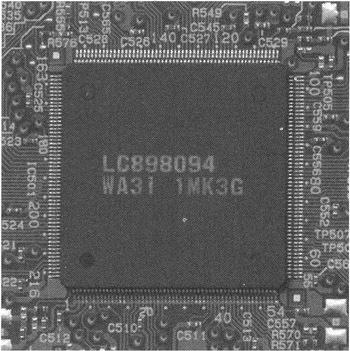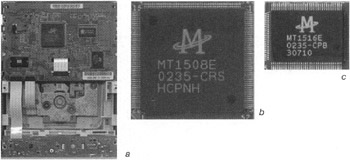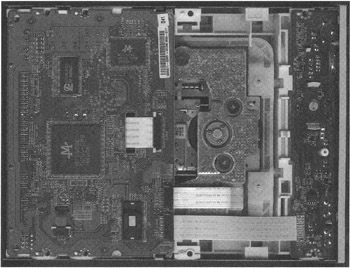Overclocking Optical Drives
|
| < Day Day Up > |
|
Most optical drives, including those for CD-ROM, CD-R, CD-RW, and numerous DVD models, are intended for use within the PCs. Generally, they are connected to the PCI bus via the ATA/33 interface.
Most problems caused by high PCI bus frequencies with these IDE devices are similar to the problems with hard disks. The list of such problems includes errors, violation of temperature modes, and even failure of the device.
However, these devices have overclocking methods different from the traditional increase of clock frequencies.
One such method, which ensures the employment of undocumented functionality, is modification of the microcode that controls the optical device. (Information on this topic is provided from materials and with the permission of Russian-language Web sites http://www.ixbt.com and http://www.overclockers.ru.)
The controlling microcode is written into the flash memory chip included in each optical drive. Replacing the microcode with a newer version typically increases the operating speed of the optical drive. For devices with writing capabilities, it widens the range of media and writing modes.
This method is not new. There are numerous online discussions and entire Web sites dedicated to this topic. Furthermore, vast libraries make available for downloading various microcode versions and utilities for the most popular drive types and models.
New versions of microcodes also are available at the official sites of optical drive manufacturers. Usually, these versions include useful additions and corrections of known bugs. As with motherboard BIOS versions, you must follow special procedures to obtain a newer version of software code, and you must update the contents of flash memory using specialized tools. This has the same advantages and drawbacks typical of BIOS updating.
Some optical drives include unique chips; therefore, the microcodes and updating utilities also might be unique. However, most manufacturers use base products and sell them under their respective trademarks.
As a result of such a business practice, most optical drives are based on a limited number of device types. Because of this, you may encounter "twins" among the devices that at first seem to be of different types and bear different names. For such products, the microcodes and software updating utilities are interchangeable. Furthermore, because such devices are sometimes positioned in different categories, replacing the microcode can improve the device rating by increasing its functionality and widening its functional parameters.
The Teac CD-W512EB CD-RW drive is an illustrative example of this statement. Replacing the 2.0A microcode with version 2.0B adds the possibility of writing disks in the DAO-RAW mode.
Another example that implements hidden device potential shifts the LG-8083B (4/4/32) CD-RW device to the LG-8080B (8/4/32) model. The procedures for performing this modification are described in detail at http://www.cdrinfo.com. The procedure is straightforward and only requires replacement of the microcode.
Pay attention to the following circumstances that accompany the procedure of replacing the microcode in optical drives:
-
Unauthorized use of the microcode might violate someone's copyright.
-
An error in code choice can result in partial or complete loss of device usability, as well as the device's warranty.
-
As a rule, it is impossible to convert a low-end device into a high-end device. By updating the microcode, you usually can increase the device rating by one or two steps within the model row.
-
Besides increasing speed, microcode modification can remove limitations for viewing DVD films. This may violate copyright law and rules regulating DVD devices and media sales.
One of the most popular utilities for changing the microcode of optical drives is MTK WinFlash. It performs this operation under Windows operating systems and under DOS.
This utility works with drives based on the MediaTek chip; therefore, it is suitable only for a limited number of drive models (Fig. 15.4).

Figure 15.4: MT1508E chip from MediaTek
When solving problems related to updating microcode, bear in mind that a device belonging to a group released by one manufacturer may not use the same chips as other devices in the group.
A good example of this is Teac. For some time, this manufacturer has used chips from Sanyo in its products. For example, the Sanyo LC898098 chip is a main chip in the Teac CD-W524E device. However, the Teac CD-W540E drive uses the Sanyo LC898094 chip (Fig. 15.5).

Figure 15.5: LC898094 chip from Sanyo
Later, Teac started to use chips from MediaTek for its CD-RW drives, including CD-W548E (Fig. 15.6).

Figure 15.6: Teac CD-W548E CD-RW drive (a) and MediaTek chipset (b and c)
A similar situation exists for TDK products. The devices manufactured by this company rely on drives from different market segments: A drive manufactured by Ricoh is intended for low-end and intermediate TDK devices; a drive manufactured by Sanyo is oriented toward high-end TDK devices. With its CyClone 401248B optical drive, TDK changed its direction and used MediaTek chips (Fig. 15.7).

Figure 15.7: TDK CyClone 401248B CD-RW drive
The technical characteristics and outward appearance of the Asus CRW2410S design reproduce the Sanyo BP-1500 drive. The basis of the Asus CD-RW drive is Sanyo's LC898098Y UF8 1FK3G chip. The same is true for a similar product from TDK.
A more advanced Asus product — CRW4012A — is based on the MT1508E chip from MediaTek (Fig. 15.8).

Figure 15.8: Asus CRW4012A CD-RW drive
These examples show that different chips frequently are used in optical drives from the same manufacturer. With any drive, it is necessary to make sure that the microcode-updating utility is compatible with the chip version.
When deciding to update an optical device, it is necessary to correctly evaluate the necessity of this step. It is hardly expedient to try to get the maximum performance from a drive only a few months old. The performance gain obtained during the writing of a standard 700 MB disk using a 48x device will be insignificant in comparison to that of the 40x device, whose warranty will be lost. In addition, contemporary drives tune their writing speed to the media quality. Users who want to economize often use cheap media, which cannot be written with the required quality at high speeds.
Nevertheless, in some cases, the replacement of the existing microcode and the use of updated drivers can boost performance, make new modes available, improve the operating stability, and increase the capacity of traditional media.
For example, in 2002, the Sanyo Electric division announced that it had developed a new technology for writing optical disks, known as HD-Burn (High-Density Burn). This technology writes 1.4 GB — almost twice the typical amount of data on standard CD-R media.
Researchers from http://www.fcenter.ru attribute such a high writing density to two innovations. First, Sanyo decreased the size of the groove on the media surface from 0.83 micrometers (μm) to 0.62 μm. This allowed the company to increase the media capacity 1.34 times. The second innovation was a new technology for error correction, the Reed-Solomon (RS) product code. This new technology ensures a capacity increase of 1.49 times. As a result, the total increase nearly doubled the media capacity.
| CD-R | HD-Burn | Capacity increase | |
|---|---|---|---|
| Minimum track width | 0.83 μm | 0.62 μm | 1.343 |
| Error correction algorithm | CIRC | RS product code | 1.489 |
| Media capacity | 700 MB (type 80) | 1,400 MB (type 80) | 2.000 |
Using the HD-Burn technology, disks can be written at a speed of 36x and read at a speed of 80x. Protection against buffer underflow is supported. It is also possible to write to CD-RW media; the write speed would be 24x. This technology is incompatible with audio CD technology. Up to 30 minutes of video data can be written to such a compressed disc in the DVD-Video format (at a resolution of 720 × 576).
For now, manufacturers that supported this technology are few. (Among them are Lite-On and BenQ.) It may be used as a useful addition in DVD/CD-RW drives, but cannot replace DVD. However, if information won't fit on a single CD but would use little space on a DVD, HD-Burn is expected to be helpful. Sanyo also plans to create a technology for threefold data-write compression, which could make the following media capacities available: 700 MB, 1.4 GB, and 2.1 GB.
In conclusion, modification can give standard products new functional capabilities. Updating the software code stored in the flash memory chips of optical devices can make these devices faster, enable them to write media that requires a higher capacity, and improve performance. This can be considered correct and justified overclocking.
|
| < Day Day Up > |
|
EAN: 2147483647
Pages: 111